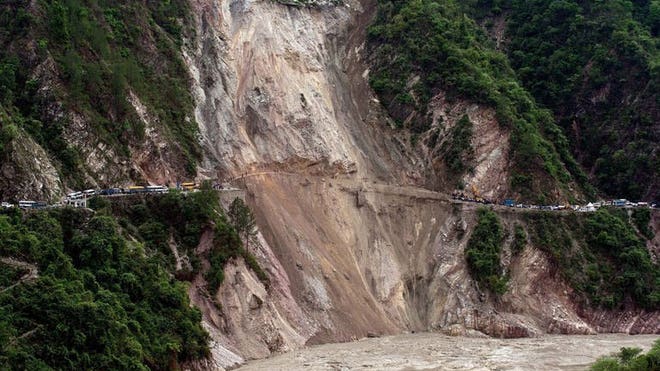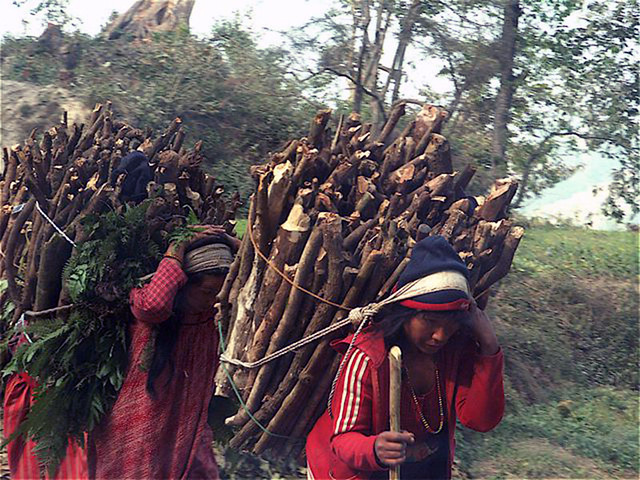.jpg) After
getting back from the trek, we still had 2 full days in Pokhara (except for
Peter who had to get back early for a field trip), so our adventure was still
not over. The day after our trek the rest of us spent the morning shopping and then
went on a half-day rafting adventure on the Upper Seti river. The two days
before we went the rafting trips had been cancelled on the river because the
water was too dangerous from all the rain we’d had. And it was definitely
pretty wild still when we went. The whole time, I was saying how I wanted it to
get super rough to be more exciting and I wanted to fall in. Well, I got my
wish. On one of the big rapids, our guide Santosh called for us to get down but
apparently I didn’t get down far enough and fell out of the boat and was pulled
under the water for a good 10 seconds, before I bobbed up and was thrown against
the rocks and heavy rapids. Finally, one of the rescue kayaks was in front of
me and I was able to grab it and be dragged to shore, coughing up half the Seti
River. It’s more than a week later now and my neck is still sore from the
whiplash I got on that ride. Meanwhile, the raft got stuck in the hole in the
rapids for nearly a minute, throwing off 2 other rafters who had been trying to
throw ropes to me and Juliana and Lu were panicking. Juliana apparently thought
I had gotten stuck under the raft and was dead at that point so was freaking
out a bit. Looking back, it’s probably one of the funniest moments of our trip, but it definitely wasn't at the time!
After
getting back from the trek, we still had 2 full days in Pokhara (except for
Peter who had to get back early for a field trip), so our adventure was still
not over. The day after our trek the rest of us spent the morning shopping and then
went on a half-day rafting adventure on the Upper Seti river. The two days
before we went the rafting trips had been cancelled on the river because the
water was too dangerous from all the rain we’d had. And it was definitely
pretty wild still when we went. The whole time, I was saying how I wanted it to
get super rough to be more exciting and I wanted to fall in. Well, I got my
wish. On one of the big rapids, our guide Santosh called for us to get down but
apparently I didn’t get down far enough and fell out of the boat and was pulled
under the water for a good 10 seconds, before I bobbed up and was thrown against
the rocks and heavy rapids. Finally, one of the rescue kayaks was in front of
me and I was able to grab it and be dragged to shore, coughing up half the Seti
River. It’s more than a week later now and my neck is still sore from the
whiplash I got on that ride. Meanwhile, the raft got stuck in the hole in the
rapids for nearly a minute, throwing off 2 other rafters who had been trying to
throw ropes to me and Juliana and Lu were panicking. Juliana apparently thought
I had gotten stuck under the raft and was dead at that point so was freaking
out a bit. Looking back, it’s probably one of the funniest moments of our trip, but it definitely wasn't at the time! Later
that evening we were invited by one of our fellow Canadian rafters to go hang
out with all the staff from the rafting company at the bar. There we learned
how to play one of Nepali’s most popular board games, called Carrom. It’s kind
of a mix between shuffleboard and pool where you flick discs with your fingers
to try and get them in the pockets. It is super hard and I definitely won’t be
placing any bets on my carrom skills any time soon.
Later
that evening we were invited by one of our fellow Canadian rafters to go hang
out with all the staff from the rafting company at the bar. There we learned
how to play one of Nepali’s most popular board games, called Carrom. It’s kind
of a mix between shuffleboard and pool where you flick discs with your fingers
to try and get them in the pockets. It is super hard and I definitely won’t be
placing any bets on my carrom skills any time soon.
On
our last full day in Pokhara we decided to start off with a bicycle ride. We
intended to go to Devi’s Falls, a nearby waterfall, but went the wrong way so
instead decided to bike around the lake. As we got to the other side of the
lake and away from the tourist area, it was then that of course we were given a
little extra dose of fun. As I went over a speed bump, the bike jumped a bit
and as it came down, one half of the handlebar completely snapped off, clean
through, and I was dumped on the road. I was a tad bewildered and unsure how I
was going to get back because it would’ve taken a couple hours walking. A bunch
of villagers came over to see if I was ok. They were incredibly nice and one
man took me to his woodshop, where he reattached the handle by carving a small
wooden stick that could go inside the handle to keep it together. I couldn’t
use it still but the stick held it together enough that I could get back. Then
as we finally started heading back, we discovered Juliana’s tire had gone
entirely flat in the meantime, which we weren’t able to fix. So we had to
slowly make our way all the way back to town with two of the four bikes broken.
 Later
in the day, we rented a boat and went out on the lake. After all the events
that had happened, we were half expecting the boat to just sink when we got to
the middle of the lake. But we had no incidents luckily, and were able to go
out and escape the noise of everything for a bit. It was a really relaxing way
to end our vacation. On the Sunday, we bussed back to Kathmandu, ready to get
back into work again on Monday, having experienced an amazingly adventurous
Nepal vacation experience.
Later
in the day, we rented a boat and went out on the lake. After all the events
that had happened, we were half expecting the boat to just sink when we got to
the middle of the lake. But we had no incidents luckily, and were able to go
out and escape the noise of everything for a bit. It was a really relaxing way
to end our vacation. On the Sunday, we bussed back to Kathmandu, ready to get
back into work again on Monday, having experienced an amazingly adventurous
Nepal vacation experience.Now, we continue the holiday season with the 5-day Tihar festival starting this Saturday. I'll be staying near Kathmandu in Bhaktapur and Nagarkot, but I'm sure to have more exciting times.
















